13.3.3: Medieval period
- Last updated
- Save as PDF
- Page ID
- 88685
\( \newcommand{\vecs}[1]{\overset { \scriptstyle \rightharpoonup} {\mathbf{#1}} } \)
\( \newcommand{\vecd}[1]{\overset{-\!-\!\rightharpoonup}{\vphantom{a}\smash {#1}}} \)
\( \newcommand{\id}{\mathrm{id}}\) \( \newcommand{\Span}{\mathrm{span}}\)
( \newcommand{\kernel}{\mathrm{null}\,}\) \( \newcommand{\range}{\mathrm{range}\,}\)
\( \newcommand{\RealPart}{\mathrm{Re}}\) \( \newcommand{\ImaginaryPart}{\mathrm{Im}}\)
\( \newcommand{\Argument}{\mathrm{Arg}}\) \( \newcommand{\norm}[1]{\| #1 \|}\)
\( \newcommand{\inner}[2]{\langle #1, #2 \rangle}\)
\( \newcommand{\Span}{\mathrm{span}}\)
\( \newcommand{\id}{\mathrm{id}}\)
\( \newcommand{\Span}{\mathrm{span}}\)
\( \newcommand{\kernel}{\mathrm{null}\,}\)
\( \newcommand{\range}{\mathrm{range}\,}\)
\( \newcommand{\RealPart}{\mathrm{Re}}\)
\( \newcommand{\ImaginaryPart}{\mathrm{Im}}\)
\( \newcommand{\Argument}{\mathrm{Arg}}\)
\( \newcommand{\norm}[1]{\| #1 \|}\)
\( \newcommand{\inner}[2]{\langle #1, #2 \rangle}\)
\( \newcommand{\Span}{\mathrm{span}}\) \( \newcommand{\AA}{\unicode[.8,0]{x212B}}\)
\( \newcommand{\vectorA}[1]{\vec{#1}} % arrow\)
\( \newcommand{\vectorAt}[1]{\vec{\text{#1}}} % arrow\)
\( \newcommand{\vectorB}[1]{\overset { \scriptstyle \rightharpoonup} {\mathbf{#1}} } \)
\( \newcommand{\vectorC}[1]{\textbf{#1}} \)
\( \newcommand{\vectorD}[1]{\overrightarrow{#1}} \)
\( \newcommand{\vectorDt}[1]{\overrightarrow{\text{#1}}} \)
\( \newcommand{\vectE}[1]{\overset{-\!-\!\rightharpoonup}{\vphantom{a}\smash{\mathbf {#1}}}} \)
\( \newcommand{\vecs}[1]{\overset { \scriptstyle \rightharpoonup} {\mathbf{#1}} } \)
\( \newcommand{\vecd}[1]{\overset{-\!-\!\rightharpoonup}{\vphantom{a}\smash {#1}}} \)
\(\newcommand{\avec}{\mathbf a}\) \(\newcommand{\bvec}{\mathbf b}\) \(\newcommand{\cvec}{\mathbf c}\) \(\newcommand{\dvec}{\mathbf d}\) \(\newcommand{\dtil}{\widetilde{\mathbf d}}\) \(\newcommand{\evec}{\mathbf e}\) \(\newcommand{\fvec}{\mathbf f}\) \(\newcommand{\nvec}{\mathbf n}\) \(\newcommand{\pvec}{\mathbf p}\) \(\newcommand{\qvec}{\mathbf q}\) \(\newcommand{\svec}{\mathbf s}\) \(\newcommand{\tvec}{\mathbf t}\) \(\newcommand{\uvec}{\mathbf u}\) \(\newcommand{\vvec}{\mathbf v}\) \(\newcommand{\wvec}{\mathbf w}\) \(\newcommand{\xvec}{\mathbf x}\) \(\newcommand{\yvec}{\mathbf y}\) \(\newcommand{\zvec}{\mathbf z}\) \(\newcommand{\rvec}{\mathbf r}\) \(\newcommand{\mvec}{\mathbf m}\) \(\newcommand{\zerovec}{\mathbf 0}\) \(\newcommand{\onevec}{\mathbf 1}\) \(\newcommand{\real}{\mathbb R}\) \(\newcommand{\twovec}[2]{\left[\begin{array}{r}#1 \\ #2 \end{array}\right]}\) \(\newcommand{\ctwovec}[2]{\left[\begin{array}{c}#1 \\ #2 \end{array}\right]}\) \(\newcommand{\threevec}[3]{\left[\begin{array}{r}#1 \\ #2 \\ #3 \end{array}\right]}\) \(\newcommand{\cthreevec}[3]{\left[\begin{array}{c}#1 \\ #2 \\ #3 \end{array}\right]}\) \(\newcommand{\fourvec}[4]{\left[\begin{array}{r}#1 \\ #2 \\ #3 \\ #4 \end{array}\right]}\) \(\newcommand{\cfourvec}[4]{\left[\begin{array}{c}#1 \\ #2 \\ #3 \\ #4 \end{array}\right]}\) \(\newcommand{\fivevec}[5]{\left[\begin{array}{r}#1 \\ #2 \\ #3 \\ #4 \\ #5 \\ \end{array}\right]}\) \(\newcommand{\cfivevec}[5]{\left[\begin{array}{c}#1 \\ #2 \\ #3 \\ #4 \\ #5 \\ \end{array}\right]}\) \(\newcommand{\mattwo}[4]{\left[\begin{array}{rr}#1 \amp #2 \\ #3 \amp #4 \\ \end{array}\right]}\) \(\newcommand{\laspan}[1]{\text{Span}\{#1\}}\) \(\newcommand{\bcal}{\cal B}\) \(\newcommand{\ccal}{\cal C}\) \(\newcommand{\scal}{\cal S}\) \(\newcommand{\wcal}{\cal W}\) \(\newcommand{\ecal}{\cal E}\) \(\newcommand{\coords}[2]{\left\{#1\right\}_{#2}}\) \(\newcommand{\gray}[1]{\color{gray}{#1}}\) \(\newcommand{\lgray}[1]{\color{lightgray}{#1}}\) \(\newcommand{\rank}{\operatorname{rank}}\) \(\newcommand{\row}{\text{Row}}\) \(\newcommand{\col}{\text{Col}}\) \(\renewcommand{\row}{\text{Row}}\) \(\newcommand{\nul}{\text{Nul}}\) \(\newcommand{\var}{\text{Var}}\) \(\newcommand{\corr}{\text{corr}}\) \(\newcommand{\len}[1]{\left|#1\right|}\) \(\newcommand{\bbar}{\overline{\bvec}}\) \(\newcommand{\bhat}{\widehat{\bvec}}\) \(\newcommand{\bperp}{\bvec^\perp}\) \(\newcommand{\xhat}{\widehat{\xvec}}\) \(\newcommand{\vhat}{\widehat{\vvec}}\) \(\newcommand{\uhat}{\widehat{\uvec}}\) \(\newcommand{\what}{\widehat{\wvec}}\) \(\newcommand{\Sighat}{\widehat{\Sigma}}\) \(\newcommand{\lt}{<}\) \(\newcommand{\gt}{>}\) \(\newcommand{\amp}{&}\) \(\definecolor{fillinmathshade}{gray}{0.9}\)The Medieval period
This period saw the Crusades, the Mongol invasions, and the rise of the powerful Timurid empire.
c. 900 - 1517 C.E.
Arts of the Islamic world: The medieval period
For many, the Muslim world in the medieval period (900-1300) means the crusades. While this era was marked, in part, by military struggle, it is also overwhelmingly a period of peaceable exchanges of goods and ideas between West and East. Both the Christian and Islamic civilizations underwent great transformations and internal struggles during these years. In the Islamic world, dynasties fractured and began to develop distinctive styles of art. For the first time, disparate Islamic states existed at the same time. And although the Abbasid caliphate did not fully dissolve until 1258, other dynasties began to form, even before its end.
Fatimid (909-1171)

In the tenth century, the Fatimid dynasty emerged and posed a threat to the rule of the Abbasids. The Fatimid rulers, part of the Shi’ia faction, took their name from Fatima, Muhammad’s daughter, from whom they claimed to be descended. The Sunnis, on the other hand, had previously pledged their alliance to Mu’awiya, the founder of the Umayyad dynasty. At the height of their power, the Fatimids claimed lands from present-day Algeria to Syria. They conquered Egypt in 969 and founded the city of Cairo as their capital.
The Fatimid rulers expanded the power of the caliph and emphasized the importance of palace architecture. Mosques too were commissioned by royalty and every aspect of their decoration was of the highest caliber, from expertly-carved wooden minbars (where the spiritual leader guides prayers inside the mosque) to handcrafted metal lamps.
The wealth of the Fatimid court led to a general bourgeoning of the craft trade even outside of the religious context. Centers near Cairo became well known for ceramics, glass, metal, wood, and especially for lucrative textile production. The style of ornament developed as well, and artisans began to experiment with different forms of abstracted vegetal ornament and human figures.
This period is often called the Islamic renaissance, for its booming trade in decorative objects as well as the high quality of its artwork.
Saljuq (1040-1157/1081-1307)

The Saljuq rulers were of Central Asian Turkic origin. Once they assumed power after 1040, the Seljuqs introduced Islam to places it had not been heretofore. The Seljuqs of Rum (referring to Rome) ruled much of Anatolia, what is now Turkey (between 1040 and 1157), while the Seljuqs of present-day Iran controlled the rest of the empire (from 1081 to 1307).
The Saljuqs of Iran were great supporters of education and the arts and they founded a number of important madrasas (schools) during their brief reign. The congregational mosques they erected began using a four-iwan plan: these incorporate four immense doorways (iwans) in the center of each wall of a courtyard.

The art of the Anatolian Saljuqs looks quite different, perhaps explaining why it is often labeled as a distinct sultanate. The inhabitants of this newly conquered land in Anatolia included members of various religions (largely Buddhists and Shamen), other heritages, and the Byzantine and Armenian Christian traditions. Saljuq projects often drew from these existing indigenous traditions—just as had been the case with the earliest Islamic buildings. Building materials included stone, brick, and wood, and there existed a widespread representation of animals and figures (some human) that had all but disappeared from architecture elsewhere in Islamic-ruled lands. The craftsmen here made great strides in the area of woodcarving, combining the elaborate scrolling and geometric forms typical of the Arabic aesthetic with wood, a medium indigenous to Turkey (and rarer in the desert climate of the Middle East).
Mamluk (1250-1517)
The name ‘Mamluk’, like many names, was given by later historians. The word itself means ‘owned’ in Arabic. It refers to the Turkic slaves who served as soldiers for the Ayyubid sultanate before revolting and rising to power. The Mamluks ruled over key lands in the Middle East, including Mecca and Medina. Their capital at Cairo became the artistic and economic center of the Islamic world at this time.

The period saw a great production of art and architecture, particularly those commissioned by the reigning sultans. Patronizing the arts and creating monumental structures was a way for leaders to display their wealth and make their power visible within the landscape of the city. The Mamluks constructed countless mosques, madrasas and mausolea that were lavishly furnished and decorated. Mamluk decorative objects, particularly glasswork, became renowned throughout the Mediterranean. The empire benefitted from the trade of these goods economically and culturally, as Mamluk craftsmen began to incorporate elements gleaned from contact with other groups. The growing prevalence of trade with China and exposure to Chinese goods, for instance, led to the Mamluk production of blue and white ceramics, an imitation of porcelain typical of the Far East.
The Mamluk sultanate was generally prosperous, in part supported by pilgrims to Mecca and Medina as well as a flourishing textile market, but in 1517 the Mamluk sultanate was overtaken and absorbed into the growing Ottoman empire.
The Great Mosque (or Masjid-e Jameh) of Isfahan

Most cities with sizable Muslim populations possess a primary congregational mosque. Diverse in design and dimensions, they can illustrate the style of the period or geographic region, the choices of the patron, and the expertise of the architect. Congregational mosques are often expanded in conjunction with the growth and needs of the umma, or Muslim community; however, it is uncommon for such expansion and modification to continue over a span of a thousand years. The Great Mosque of Isfahan in Iran is unique in this regard and thus enjoys a special place in the history of Islamic architecture. Its present configuration is the sum of building and decorating activities carried out from the 8th through the 20th centuries. It is an architectural documentary, visually embodying the political exigencies and aesthetic tastes of the great Islamic empires of Persia.

Another distinctive aspect of the mosque is its urban integration. Positioned at the center of the old city, the mosque shares walls with other buildings abutting its perimeter. Due to its immense size and its numerous entrances (all except one inaccessible now), it formed a pedestrian hub, connecting the arterial network of paths crisscrossing the city. Far from being an insular sacred monument, the mosque facilitated public mobility and commercial activity thus transcending its principal function as a place for prayer alone.
The mosque’s core structure dates primarily from the 11th century when the Seljuk Turks established Isfahan as their capital. Additions and alterations were made during Il-Khanid, Timurid, Safavid, and Qajar rule. An earlier mosque with a single inner courtyard already existed on the current location. Under the reign of Malik Shah I (ruled 1072-1092) and his immediate successors, the mosque grew to its current four-iwan design. Indeed, the Great Mosque of Isfahan is considered the prototype for future four-iwan mosques (an iwan is a vaulted space that opens on one side to a courtyard).

Linking the four iwans at the center is a large courtyard open to the air, which provides a tranquil space from the hustle and bustle of the city. Brick piers and columns support the roofing system and allow prayer halls to extend away from this central courtyard on each side. Aerial photographs of the building provide an interesting view; the mosque’s roof has the appearance of “bubble wrap” formed through the panoply of unusual but charming domes crowning its hypostyle interior.

This simplicity of the earth-colored exterior belies the complexity of its internal decor. Dome soffits (undersides) are crafted in varied geometric designs and often include an oculus, a circular opening to the sky. Vaults, sometimes ribbed, offer lighting and ventilation to an otherwise dark space. Creative arrangement of bricks, intricate motifs in stucco, and sumptuous tile-work (later additions) harmonize the interior while simultaneously delighting the viewer at every turn. In this manner, movement within the mosque becomes a journey of discovery and a stroll across time.

Given its sprawling expanse, one can imagine how difficult it would be to locate the correct direction for prayer. The qibla iwan on the southern side of the courtyard solves this conundrum. It is the only one flanked by two cylindrical minarets and also serves as the entrance to one of two large, domed chambers within the mosque. Similar to its three counterparts, this iwan sports colorful tile decoration and muqarnas or traditional Islamic cusped niches. The domed interior was reserved for the use of the ruler and gives access to the main mihrab of the mosque.

The second domed room lies on a longitudinal axis right across the double-arcaded courtyard. This opposite placement and varied decoration underscores the political enmity between the respective patrons; each dome vies for primacy through its position and architectural articulation. Nizam al-Mulk, vizier to Malik Shah I, commissioned the qibla dome in 1086. But a year later, he fell out of favor with the ruler and Taj al-Mulk, his nemesis, with support from female members of the court, quickly replaced him. The new vizier’s dome (below), built in 1088, is smaller but considered a masterpiece of proportions.

When Shah Abbas I, a Safavid dynasty ruler, decided to move the capital of his empire from Qazvin to Isfahan in the late 16th century, he crafted a completely new imperial and mercantile center away from the old Seljuk city. While the new square and its adjoining buildings, renowned for their exquisite decorations, renewed Isfahan’s prestige among the early modern cities of the world, the significance of the Seljuk mosque and its influence on the population was not forgotten. This link amongst the political, commercial, social, and religious activities is nowhere more emphasized than in the architectural layout of Isfahan’s covered bazaar. Its massive brick vaulting and lengthy, sinuous route connects the Safavid center to the city’s ancient heart, the Great Mosque of Isfahan.
Folio from a Qur’an
by ALEX BREY

The Qur’an: From recitation to book
The Qur’an is the sacred text of Islam, consisting of the divine revelation to the Prophet Muhammad in Arabic. Over the course of the first century and a half of Islam, the form of the manuscript was adapted to suit the dignity and splendor of this divine revelation. However, the word Qur’an, which means “recitation,” suggests that manuscripts were of secondary importance to oral tradition. In fact, the 114 suras (or chapters) of the Qur’an were compiled into a textual format, organized from longest to shortest, only after the death of Muhammad, although scholars still debate exactly when this might have occurred.
This two-page spread (or bifolium) of a Qur’an manuscript, which contains the beginning of Surat Al-‘Ankabut (The Spider), is now in the collection of The Morgan Library and Museum in New York. Other folios that appear to be from the same Qur’an survive in the Chester Beatty Library (Dublin), the Topkapı Palace Museum and the Museum of Turkish and Islamic Art (Istanbul), and the National Museum of Syria (Damascus). One page includes an inscription, which states that ʿAbd al-Munʿim Ibn Aḥmad donated the Qur’an to the Great Mosque of Damascus in 298 A.H. (July, 911 C.E.), although we do not know where or how long before this donation the manuscript was produced.

A roadmap for readers
The main text of the mushaf (pronounced muss-hoff), as manuscripts of the Qur’an are known, is written in brown ink. Arabic, the language of the divine word of Islam, is read from right to left. Several consonants share the same basic letterform, and these are usually distinguished from each other by lines or dots placed above or below the letter. Short vowels such as a, u, and i, are not normally written in Arabic, but in order to avoid misreadings of such an important text it quickly became standard to include vowels in the Qur’an. In this manuscript, these short vowels are marked with red circles positioned above, next to, or below the consonants, depending on the vowel.

The text of each sura is further divided into verses by triangles made up of 5 gold circles located at the end of each verse (left).
The title of each sura is written in gold ink, and surrounded by a rectangle, filled here with an undulating golden vine (below). Combined with a rounded palmette extending into the margin of the folio, it allows readers to quickly locate the beginning of each sura.
Because figural imagery such as human or animal forms was considered inappropriate for the ornamentation of sacred monuments and objects, artists relied on vegetal and geometric motifs when they decorated mosques and sacred manuscripts. Vines and palmettes like the ones that surround the sura heading here appear alone in sacred contexts, but they also accompanied animal and human forms in the secular decoration of palaces and textiles.

Planning the proportions of the page
The art of producing a mushaf began well before a pen was ever dipped into ink. The dimensions of each page were calculated before the parchment was cut, and the text was carefully situated relative to the edges of the pages. Each page of costly parchment (or vellum) in this Qur’an is larger than a standard sheet of printer paper, and contains only nine lines of calligraphy. These materials suggest both the dignity of the sacred text and the wealth of its patron, who was probably a member of the aristocratic elite.

In addition to the high quality and large quantity of materials used, the deliberate geometric planning of the page conveys the importance of the text that it contains. As in many of the mushafs produced between 750 and 1000 C.E., the pages of this manuscript are wider than they are tall.
The text-block of this manuscript has a height-to-width ratio of 2:3, and the width of the text-block is approximately equal to the height of the page. The height of each line of text was derived from the first letter of the alphabet, alif, which was in turn derived from the width of the nib of the reed pen used by the calligraphers to write the text.

Each line was further divided into a set number of “interlines,” which were used to determine the heights of various parts of individual letters. There is no ruling on the parchment, however, so scribes probably placed each sheet of the semi-transparent parchment on a board marked with horizontal guidelines as they wrote. Memorizing and producing the proportions of each pen stroke, however, must have been part of the training of every scribe.

Kufic script and the specialization of scribes
Writing in the tenth century C.E., the Abbasid court secretary Ibn Durustuyah noted that letters of the alphabet were written differently by Qur’anic scribes, professional secretaries, and other copyists. The calligraphic style used by these early scribes of the Qur’an is known today as Kufic. Only two or three of the more than 1300 fragments and manuscripts written in Kufic that survive contain non-Qur’anic content.
Kufic is not so much a single type of handwriting as it is a family of 17 related styles based on common principles, including a preference for strokes of relatively uniform thickness, short straight vertical lines and long horizontal lines, and a straight, horizontal baseline.
Various types of kufic were popular from the seventh century C.E. until the late tenth century C.E. Scribes used a wide reed pen dipped in ink to write. In some letters the angle of the pen was adjusted as the scribe wrote in order to maintain an even thickness throughout the entire letterform, but in others the angle could be held constant in order to produce both very thick and very thin lines. Although letters and even entire words at first appear to consist of a single stroke of the pen, in fact individual letters were often formed using multiple strokes.

The regularity and precision of the penmanship in the fragment from The Morgan Library reveals the skill of the scribes who produced it. Each of them deliberately imitated a single style in order to produce a unified finished product.
Scribes also had some freedom in composing a page. They could emphasize individual words and balance the widths of lines of different length by elongating certain letters horizontally (a technique known as mashq). They could also adjust spacing between words and letters, and even split words between two lines, in order to balance positive and negative space across the page.

In this mushaf, the spaces between non-connecting characters within a word are as wide as the spaces that separate different words (sometimes even wider!). For readers unfamiliar with the text, it is therefore difficult to figure out which letters should be grouped together to form words. This deliberate obfuscation would have slowed down readers, and it suggests that anyone who read aloud from these manuscripts had probably already memorized the text of the Qur’an and used the lavish manuscript only as a kind of mnemonic device.
Additional resources:
This manuscript at the Morgan Library and Museum
Glossary from the British Museum’s Catalogue of Illuminated Manuscripts
The development and spread of calligraphic scripts from The Metropolitan Museum of Art
Scripts in development from The Metropolitan Museum of Art
Islamic Manuscripts from the Cambridge Digital Library
Sheila Blair, Islamic Calligraphy (Edinburgh: Edinburgh University Press, 2006).
Alain George, The Rise of Islamic Calligraphy (London: Saqi, 2010).
Alain George, “The Geometry of Early Qur’anic Manuscripts.” Journal of Qur’anic Studies volume 9, no. 1 (2007), pp. 78-110.
Alain George, “Calligraphy, Colour and Light in the Blue Qur’an.” Journal of Qur’anic Studies volume 11, no. 1 (2009), pp. 75-125.
Estelle Whelan, “Writing the Word of God: Some Early Qur’an Manuscripts and Their Milieux, Part I,” Ars Orientalis volume 20 (1990), pp. 113-147.
Pyxis of al-Mughira
by DR. ELIZABETH MACAULAY-LEWIS

A pyxis is a cylindrical box used for cosmetics. Now, imagine a room in a palace where this beautifully carved ivory container is given a central place. The luxurious box sits open. Inside are small silver containers of perfume, also left open so that their sweet-smelling aromas could waft through the room, gently scenting the air. This particular pyxis was a gift to the then-eighteen-year-old al-Mughira, the son of a caliph, perhaps as a coming-of-age present.
Pyxis of al-Mughira
The Pyxis of al-Mughira, now in the Louvre, is among the best surviving examples of the royal ivory carving tradition in Al-Andalus (Islamic Spain). It was probably fashioned in the Madinat al-Zahra workshops and its intricate and exceptional carving set it apart from many other examples; it also contains an inscription and figurative work which are important for understanding the traditions of ivory carving and Islamic art in Al-Andalus.
Carved ivories in Al-Andalus (Islamic Spain)
Al-Andalus, the lands on the Iberian Peninsula (today, Spain), which were controlled by Muslims from 711 to 1492, are home to some of the most remarkable monuments of Islamic art. These include the Great Mosque of Cordoba, constructed by successive Umayyad Caliphs, and the Alhambra Palace, built by the final Islamic dynasty that controlled Al-Andalus, the Nasrids. As stunning and impressive as the architecture of Al-Andalus was, the luxury arts, specifically the exquisite textiles and intricately carved ivory artifacts, produced in in royal workshops, also flourished. One of the best examples of this tradition is the Pyxis of al-Mughira.
Since the twilight years of the Roman Empire, carved ivory objects had been important elements of the artistic canon of the Mediterranean. Ivory was durable, smooth, elegant, and easily carved, making it highly desirable for the creation of diptychs, pyxides (the plural of pyxis), and icons that could serve as single panels or could combined into diptychs or triptychs during the Byzantine Empire. Highly portable, they were often given as gifts. Although ivory carving was practiced in Constantinople, Syria and Egypt, it was a new arrival in Al-Andalus, and there are no examples of ivory carved caskets before the reign of the Umayyad caliph, ‘Abd al-Rahman III (r. 929-61).

The Pyxis of al-Mughira is decorated with four eight-lobed medallions which are surrounded by figures and animals that include falconers, wrestlers, griffons, peacocks, birds, goats and animals to be hunted. Each medallion has princely iconography.
This medallion (left) shows two men collecting eggs from the nests of Falcons, a symbol of Umayyad legitimacy.
Who were they made for?
In Al-Andalus, ivory objects, including pyxides, were bestowed upon members of the royal family, specifically sons, wives and daughters on important or memorable occasions, such as a marriage, birth or coming of age; later they were given as Caliphal gifts to important allies, such as the Berbers, who are the indigenous peoples of North Africa, many of whom converted to Islam and swore their allegiance to the Umayyad Caliphs in Spain.
A surprising number of these royal ivory objects survive in their entirety, and these are spread throughout the museum collections today (see the links below). Typically, these objects were carved out of solid ivory. Many caskets and pyxides held perfumes or cosmetics. While many pyxides were given to women, many were also given to men, including this one, which was given to al-Mughira, the youngest son of the deceased caliph ‘Abd al-Raḥmān III, when he was eighteen years old in the year AH 357/ 968 CE.

This medallion centers around a lute player flanked by two figures, one of whom holds the braided scepter and flask of the Umayyads, while the other holds a fan. Presumably the man with the spceter and flask symbolizes the Umayyad Caliph, and the figure with the fan, the Abassids.

The decoration
The pyxis was probably cut from the cross-section of an elephant’s tusk and it was adorned in highly specific, royal iconography. There are also traces of inlaid jade. Jade and other precious and semi-precious stones were used in the decoration of these boxes.
Remember, Islamic art is not strictly speaking aniconic (aniconic = the absence of human figures). Human and animal figures played a vital part in iconography. We see them here in this pyxis, which some scholars (including those at the Louvre), have interpreted as expressing the political authority and legitimacy of Umayyad Caliphs (as opposed to the Abbasid Caliphs, who ruled in Baghdad).
Another medallion shows lions attacking two bulls. As in Arabic poetry, these lions symbolize the victorious (in this case, perhaps the Umayyads).

The final scene shows men on horseback date-picking. The date-palm, found primarily in the Middle East and North Africa, may allude to the lost lands of the East (the lands under Abbasid control). This too was a theme of Umayyad poetry. The use of visual imagery which is also found in the poetry of the era demonstrates that these two art forms were in communication.
An Arabic inscription in the kufic script runs around the base of the lid and reads: “God’s blessing, favours, joy, beatitude to al-Mughira son of the Commander of the faithful, may God have mercy upon him, in the year 357.”

Some inscriptions on other ivory carvings also mention the name of the workshop and craftsman who made these exceptional pieces.
The iconography may have had a further specific message to al-Mughira. After the death of his brother, al-Hakam II, al-Mughira may have been a threat to Hisham II (r. 976-1013) and he was executed (along with his supporters). While al-Mughira met an unfortunate end, the beauty of his pyxis ensured its survival.
Additional resources:
Bloom, Jonathan, and Sheila Blair. 2009. “Ivory.” The Grove encyclopedia of Islamic art and architecture. Oxford: Oxford University Press, 331-6.
Rosser-Owen, Mariam. 2010. Islamic arts from Spain. London: V&A Publishing, 26-30.
Smarthistory images for teaching and learning:
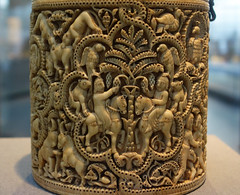
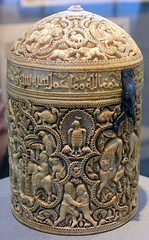
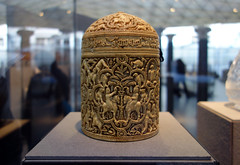
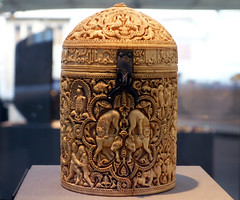
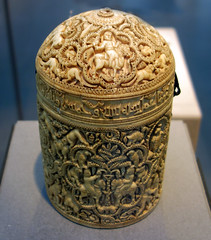
Dado Panel, Courtyard of the Royal Palace of Mas’ud III

The dado panel from the Courtyard of the Royal Palace of Mas’ud III is a fine example of the artistic preferences of the Ghaznavid dynasty, which ruled the Indian subcontinent from 977 to 1186 C.E. A dado panel is a two to three foot lower part of a wall, typically decorated in a variety of media. This dado panel formed part of a larger dado, found within the courtyard of the Palace of Mas’ud III, just south of Kabul, Afghanistan, and it is currently located in the Brooklyn Museum’s Arts of the Islamic World collection. Although the panel was not found in-situ, it closely resembles other panels found within the palace’s courtyard.


The panel can be broken up into three registers (below left). The top register contains a Kufic inscription, which would have been part of a continuous inscription that encircled the entire courtyard across the tops of multiple adjacent panels. Kufic script is a style of writing Arabic popular from the seventh century C.E. until the late tenth century C.E., as seen in the page from the Qur’an above. The central register of the dado panel is a large sequence of trefoil (tri-lobed leaf) elements with a vegetal motif, and the bottom register consists of two scrolls interlaced with each other. The panel would have been painted blue and red as well as gilded. It shows signs of wear, with markings and discoloration, most likely from exposure to various elements over time.
Uncovering a palace
The Ghaznavids were of Turkish origin, and they preferred a fusion of Iranian and Arab stylistic influences, along with a strong interest in Persian art and poetry. Their capital, Ghazni lay on an important trade route, resulting in influences from around the region. The Palace of Mas’ud III provides the best evidence for the social, cultural and artistic nature of the Ghaznavid Dynasty. The construction date is unknown but it was completed towards the end of the dynasty. It was built of a combination of baked and unbaked brick with pressed clay. It sits on a quadrangular plan organized around a central courtyard with four iwans.

The two excavations that were carried out between 1957 and 1966 produced a number of finds, including a long dado frieze in the courtyard. About forty-four panels were found in-situ and about four hundred dado fragments were also recovered. It is believed that there were about five hundred panels in all. They are made of marble, which came from a marble quarry found near Ghazni. The Ghaznavids used a large amount of marble throughout the city, during a time where brick and stucco were favored for décor purposes. The influence of the city of Baghdad, which was also built up heavily with marble by the Abbasids possibly explains the popularity of the medium at this time. Ghazni has only recently attracted scholars with the discovery of a great-stylized minaret, also dating to Mas’ud III’s reign (above).
Persian poetry

Although the Kufic inscription on this panel has not been translated, translations of other sections of the frieze contain a Persian poem that praised the Ghaznavid rulers. There is no author or written text to accompany the work, but scholars believe that the poet was someone associated with court life who probably wrote the poem for this specific purpose. This particular inscription, from the twelfth century, is one of the oldest uses of Persian in place of Arabic. It is likely that the inscription was commissioned in conjunction with the completion of the building, a practice that is also seen in Sicily and Alhambra. In Persia, it was common practice to adorn sacred and secular buildings with inscriptions (see the example from Iran, above).
Part of a larger whole
The dado panel from the Brooklyn Museum is part of a much larger work of art and a representation of the very essence of the Ghaznavid Dynasty. It is evident that the Ghazavids were deviating from the artistic and architectural norms of the time with the construction of the palace dado frieze. Not only did they follow the Abbasids’ use of marble for decorative purposes, but they also used Persian within the dado inscription, which was unique at the time. The use of the inscription on the dado as a commemorative display to honor the leaders of the dynasty and mark the construction of the building was also unusual. The use of Persian terms in place of Arab letters might have been a result of their expanding empire, of the dynasty’s influential origins, or of an appreciation for Persian literature. The dado panel at the Brooklyn Museum is a rare work of art from a period of creative nonconformity, and it is representative of the Ghaznavids’ signature artistic style.
Additional resources:
This work at the Brooklyn Museum of Art
Alessio Bombaci, The Kufic Inscription in Persian Verses in the Court of the Royal Palace of Mas’ud III at Ghazni (Rome: Insituto Italiano per Medio ed Estremo Oriente, 1966).
—- “Summary Report on the Italian Archaeological Mission in Afghanistan. Introduction to the Excavations at Ghazni,” East and West, Vol. 10, No. 1 / 2 (March-June 1959), pp. 3-22.
C. E. Bosworth, “The Ghaznavids,” UNESCO History of Civilizations of Central Asia, Vol. IVa, 2014.
Roberta Giunta, “Islamic Ghazni An IsIAO Archaeological Project in Afghanistan: A Preliminary Report (July 2004-June 2005),” East and West, Vol. 55, No. 1 / 4 (December 2005), pp. 473-484.
Two Royal Figures (Saljuq period)
by DR. ELIZABETH MACAULAY-LEWIS and DR. STEVEN ZUCKER
Video \(\PageIndex{1}\): Two Royal Figures, Iran (Saljuq period), mid 11th – mid 12th c., painted and gilded stucco (Metropolitan Museum of Art, New York)
Smarthistory images for teaching and learning:

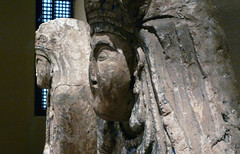
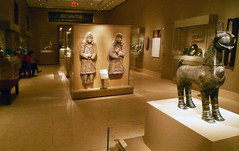

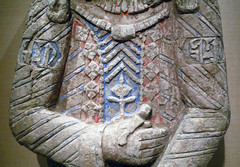
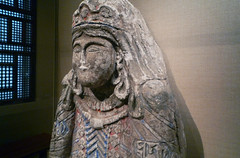
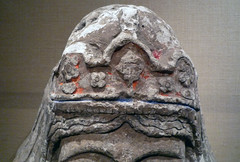

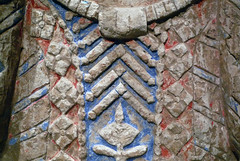

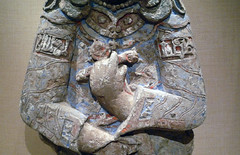

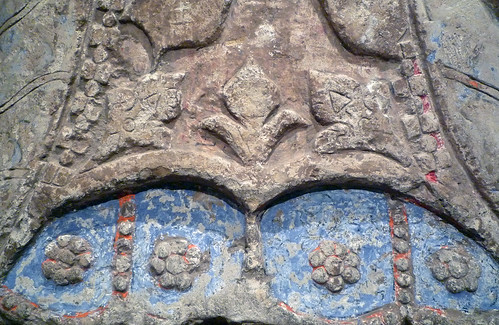
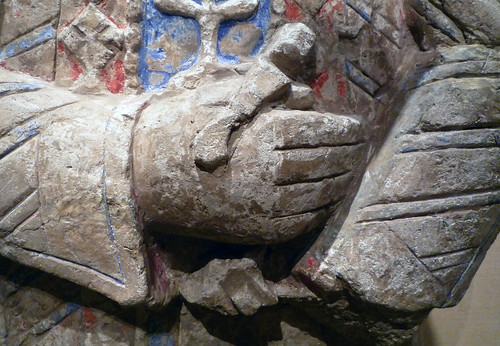
Coronation Mantle
by DR. STEVEN ZUCKER and DR. BETH HARRIS
Video \(\PageIndex{2}\): Coronation Mantle, 1133/34, fabric from Byzantium or Thebes, samite, silk, gold, pearls, filigree, sapphires, garnets, glass, and cloisonné enamel, 146 x 345 cm (Schatzkammer, Kunsthistorisches Museum, Vienna)
This was likely made for the Norman ruler Roger II in 1133/34 in the royal workshop in Palermo, using fabric from Byzantium or Thebes, Samite, silk, gold, pearls, filigree, sapphires, garnets, glass, and cloisonné enamel. The Kufic script reads:
This mantle was worked in the most magnificent clothing workshop and is connected with the desire and hopes, felicitous days and nights without cease or change, with authority, with honor and felicity, assurances of trust, reverent care, protection, good destiny, freedom from harm, triumph and livelihood in the capital city of Sicily in the year 528 [or 1133/34 in the Gregorian calendar].
Additional resources:
Eva R. Hoffman, “Pathways of Portability: Islamic and Christian interchange from the tenth to the twelfth century,” Art History, vol. 24. no. 1 (February 2001), pp. 17-50.
Smarthistory images for teaching and learning:
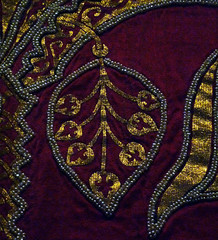
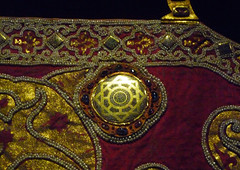
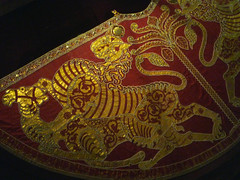
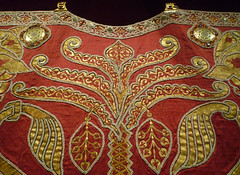
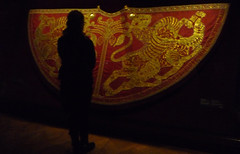
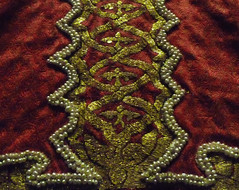
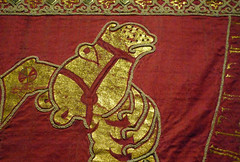
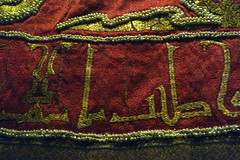
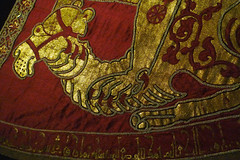
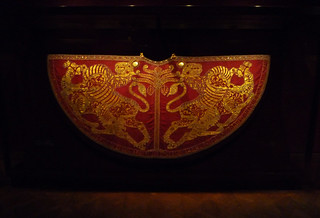
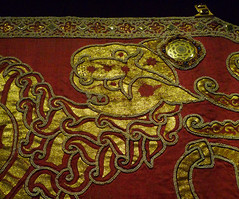
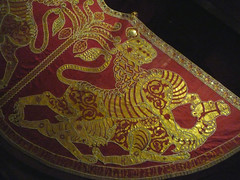
The Alhambra

The Alhambra in Granada, Spain, is distinct among Medieval palaces for its sophisticated planning, complex decorative programs, and its many enchanting gardens and fountains. Its intimate spaces are built at a human scale that visitors find elegant and inviting.
The Alhambra, an abbreviation of the Arabic: Qal’at al-Hamra, or red fort, was built by the Nasrid Dynasty (1232-1492)—the last Muslims to rule in Spain. Muhammad ibn Yusuf ibn Nasr (known as Muhammad I) founded the Nasrid Dynasty and secured this region in 1237. He began construction of his court complex, the Alhambra, on Sabika hill the following year.

Plan of the Alhambra and Generalife
1,730 meters (1 mile) of walls and thirty towers of varying size enclose this city within a city. Access was restricted to four main gates. The Alhambra’s nearly 26 acres include structures with three distinct purposes, a residence for the ruler and close family, the citadel, Alcazaba—barracks for the elite guard who were responsible for the safety of the complex, and an area called medina (or city), near the Puerta del Vino (Wine Gate), where court officials lived and worked.
The different parts of the complex are connected by paths, gardens and gates but each part of the complex could be blocked in the event of a threat. The exquisitely detailed structures with their highly ornate interior spaces and patios contrast with the plain walls of the fortress exterior.
Three palaces
The Alhambra’s most celebrated structures are the three original royal palaces. These are the Comares Palace, the Palace of the Lions, and the Partal Palace, each of which was built during 14th century. A large fourth palace was later begun by the Christian ruler, Carlos V.

El Mexuar is an audience chamber near the Comares tower at the northern edge of the complex. It was built by Ismail I as a throne room, but became a reception and meeting hall when the palaces were expanded in the 1330s. The room has complex geometric tile dadoes (lower wall panels distinct from the area above) and carved stucco panels that give it a formality suitable for receiving dignitaries (above).
The Comares Palace


Behind El Mexuar stands the formal and elaborate Comares façade set back from a courtyard and fountain. The façade is built on a raised three-stepped platform that might have served as a kind of outdoor stage for the ruler. The carved stucco façade was once painted in brilliant colors, though only traces remain.
A dark winding passage beyond the Comares façade leads to a covered patio surrounding a large courtyard with a pool, now known as the Court of the Myrtles. This was the focal point of the Comares Palace.
The Alhambra’s largest tower, the Comares Tower, contains the Salón de Comares (Hall of the Ambassadors), a throne room built by Yusuf I (1333-1354). This room exhibits the most diverse decorative and architectural arts contained in the Alhambra.

The double arched windows illuminate the room and provide breathtaking views. Additional light is provided by arched grille (lattice) windows set high in the walls. At eye level, the walls are lavishly decorated with tiles laid in intricate geometric patterns. The remaining surfaces are covered with intricately carved stucco motifs organized in bands and panels of curvilinear patterns and calligraphy.
Palace of the Lions

The Palacio de los Leones (Palace of the Lions) stands next to the Comares Palace but should be considered an independent building. The two structures were connected after Granada fell to the Christians.
Muhammad V built the Palace of the Lions’ most celebrated feature in the 14th century, a fountain with a complex hydraulic system consisting of a marble basin on the backs of twelve carved stone lions situated at the intersection of two water channels that form a cross in the rectilinear courtyard. An arched covered patio encircles the courtyard and displays fine stucco carvings held up by a series of slender columns. Two decorative pavilions protrude into the courtyard on an East–West axis (at the narrow sides of the courtyard), accentuating the royal spaces behind them.

To the West, the Sala de los Mocárabes (Muqarnas Chamber), may have functioned as an antechamber and was near the original entrance to the palace. It takes its name from the intricately carved system of brackets called “muqarnas” that hold up the vaulted ceiling.

Across the courtyard, to the East, is the Sala de los Reyes (Hall of the Kings), an elongated space divided into sections using a series of arches leading up to a vaulted muqarnas ceiling; the room has multiple alcoves, some with an unobstructed view of the courtyard, but with no known function.
This room contains paintings on the ceiling representing courtly life. The images were first painted on tanned sheepskins, in the tradition of miniature painting. They use brilliant colors and fine details and are attached to the ceiling rather than painted on it.

There are two other halls in the Palace of the Lions on the northern and southern ends; they are the Sala de las Dos Hermanas (the Hall of the Two Sisters) and the Hall of Abencerrajas (Hall of the Ambassadors). Both were residential apartments with rooms on the second floor. Each also have a large domed room sumptuously decorated with carved and painted stucco in muqarnas forms with elaborate and varying star motifs.
The Partal Palace
The Palacio del Partal (Partal Palace) was built in the early 14th century and is also known as del Pórtico (Portico Palace) because of the portico formed by a five-arched arcade at one end of a large pool. It is one of the oldest palace structures in the Alhambra complex.
Generalife

The Nasrid rulers did not limit themselves to building within the wall of the Alhambra. One of the best preserved Nasrid estates, just beyond the walls, is called Generalife (from the Arabic, Jannat al-arifa). The word jannat means paradise and by association, garden, or a place of cultivation which Generalife has in abundance. Its water channels, fountains and greenery can be understood in relation to passage 2:25 in the Koran, “…gardens, underneath which running waters flow….”
In one of the most spectacular Generalife gardens, a long narrow patio is ornamented with a water channel and two rows of water fountains. Generalife also contains a palace built in the same decorative manner as those within the Alhambra but its elaborate vegetable and ornamental gardens made this lush complex a welcome retreat for the rulers of Granada.
Interior and exterior re-imagined
To be sure, gardens and water fountains, canals, and pools are a recurring theme in construction across the Muslim dominion. Water is both practical and beautiful in architecture and in this respect the Alhambra and Generalife are no exception. But the Nasrid rulers of Granada made water integral. They brought the sound, sight and cooling qualities of water into close proximity, in gardens, courtyards, marble canals, and even directly indoors.
The Alhambra’s architecture shares many characteristics with other examples of Islamic architecture, but is singular in the way it complicates the relationship between interior and exterior. Its buildings feature shaded patios and covered walkways that pass from well-lit interior spaces onto shaded courtyards and sun-filled gardens all enlivened by the reflection of water and intricately carved stucco decoration.
More profoundly however, this is a place to reflect. Given the beauty, care and detail found at the Alhambra, it is tempting to imagine that the Nasrids planned to remain here forever; it is ironic then to see throughout the complex in the carved stucco, the words, “…no conqueror, but God” left by those that had once conquered Granada, and would themselves be conquered. It is a testament to the Alhambra that the Catholic monarchs who besieged and ultimately took the city left this complex largely intact.
Folio from a Shahnama, The Bier of Iskandar (Alexander the Great)
by DR. MASSUMEH FARHAD, FREER GALLERY OF ART and DR. STEVEN ZUCKER
Video \(\PageIndex{3}\): The Bier of Iskandar (Alexander the Great), folio from the Great Mongol Shahnama (Il-Khanid dynasty, Tabriz, Iran), c. 1330, ink, opaque watercolor and gold on paper, 57.6 x 39.7 cm (Freer Gallery of Art, Smithsonian Institution, purchase — Charles Lang Freer Endowment, F1938.3). Speakers: Dr. Massumeh Farhad, Chief Curator and The Ebrahimi Family Curator of Persian, Arab, and Turkish Art, Freer Gallery of Art and Arthur M. Sackler Gallery, Smithsonian Institution and Dr. Steven Zucker.
Additional resources:
This folio at the Freer Gallery of Art
Smarthistory images for teaching and learning:













Mohammed ibn al-Zain, Basin (Baptistère de Saint Louis)
by DR. BETH HARRIS and DR. STEVEN ZUCKER
Video \(\PageIndex{4}\): Mohammed ibn al-Zain, Basin (Baptistère de Saint Louis), c. 1320-40, brass inlaid with silver and gold, 22.2 x 50.2 cm, Egypt or Syria (Musée du Louvre, Paris)
Smarthistory images for teaching and learning:














Mihrab from Isfahan (Iran)
by DR. ELIZABETH MACAULAY-LEWIS and DR. STEVEN ZUCKER
Video \(\PageIndex{5}\): Mihrab (prayer niche), 1354–55 (A.H. 755), just after the Ilkhanid period, Isfahan, Iran, polychrome glazed tiles, 135-1/16 x 113-11/16 inches (343.1 x 288.7 cm) (Metropolitan Museum of Art, New York)
Smarthistory images for teaching and learning:
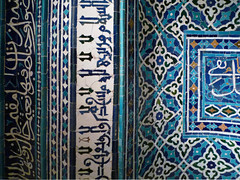
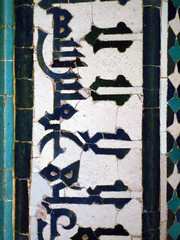
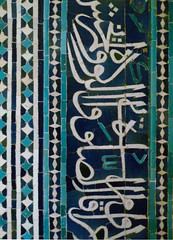
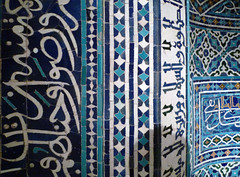
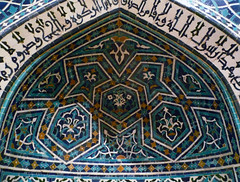
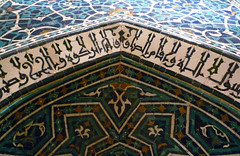
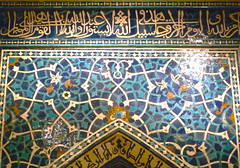
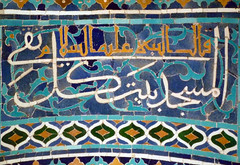
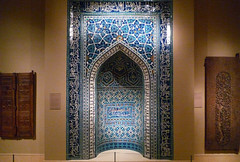
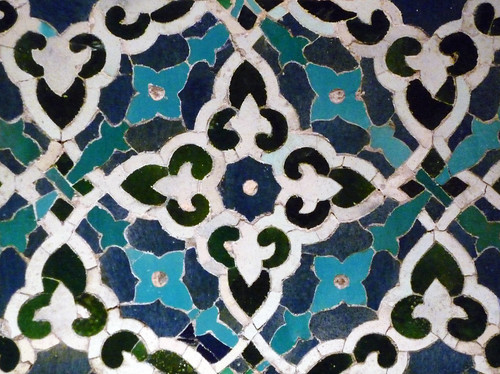
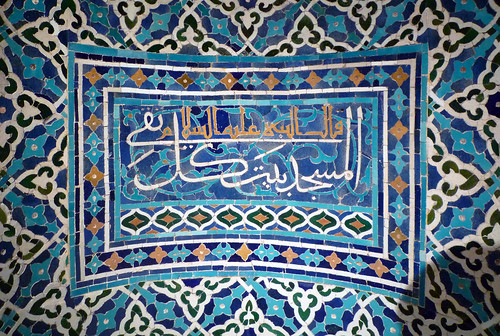
Bahram Gur Fights the Karg (Horned Wolf), Ilkhanid dynasty
by JAYNE YANTZ

As Bahram Gur’s men faced the Karg, a monstrous horned wolf that had been terrorizing the countryside, they cried, “Your majesty, this is beyond any man’s courage…tell Shangal this can’t be done….”
Bahram Gur Fights the Karg is a book illumination depicting one of the many stories from the Shahnama, the Persian Book of Kings. Though this particular image was painted in the fourteenth century by artists in the Mongol court in Persia (present-day Iran), the text of the Shahnama was composed by a poet named Firdawsi four hundred years earlier, around 1000 C.E. The Shahnama incorporates many older stories once told orally, chronicling the history of Persia before the arrival of Islam and celebrating the glories of the Persian past and its ancient heroes. The Shahnama is, in fact, still taught in Iranian schools today, and is considered to be Iran’s national epic—to know or recite the stories of the Shahnama is to express pride in the country’s glorious past. The illustration Bahram Gur Fights the Karg depicts one such story of the brave deeds of a Persian king, Bahram Gur, who singlehandedly defeated the monstrous Karg (horned wolf). It is much more than just an exciting tale, however; the Mongol artists who created this work were fulfilling their patrons’ strong desire to identify with the noble, virtuous, and powerful warrior-kings of ancient Persia.
Who was Bahram Gur and what is a Karg?

Bahram V was a king of the Sasanian empire that ruled Persia from the third to the seventh century, just prior to the arrival of Islam. His nickname, Bahram Gur, refers to a “gur” or onager—a type of wild ass which is one of the world’s fastest-running mammals. The word “gur” may also mean “swift.” He was known as a great hunter of onagers, a favorite game animal in ancient Iran, and he was renowned for his talents in warfare, chivalry, and romance. On a trip to India, according to the Shahnama, the king of India, a ruler named Shangal, recognized Bahram Gur’s abilities and sought his help in ridding the Indian countryside of the frightening and fierce Karg.

Some translations of Firdawsi’s work describe the Karg as a rhinoceros, some as a wolf, and some, as we find here in Bahram Gur Fights the Karg, as a combination of the two—a ferocious horned wolf. When Bahram Gur and his men found the lair and saw the beast, his men beseeched, “Your majesty, this is beyond any man’s courage…tell Shangal this can’t be done….” The hero, of course, went forward alone, first using his bow to weaken the Karg with arrows, then using his blade to cut off the Karg’s head to present to Shangal.
The Mongol court and the art of the book
The Sasanian empire fell in the seventh century, and it was not until well after this that the Mongols invaded Persia. They came from the eastern Asian plains, where open grasslands had encouraged a nomadic lifestyle of herding, horsemanship, and fierce warfare. They first became a serious force under the leadership of Genghis Khan in the early thirteenth century, and later, under his grandson Hulagu, the Mongols expanded their reach all the way to the Mediterranean.

Settled in Persia, the Mongols fostered the growth of cosmopolitan cities with rich courts and wealthy patrons who encouraged the arts to flourish. The rule of Hulagu’s dynasty, which lasted until 1335, is commonly known as the Ilkhanid period. Book illustration thrived under the Ilkhanids and became a major art form for both religious and secular texts. Since the Mongols began as, and largely remained, nomadic peoples (moving from place to place during the year to satisfy the needs of their herds), artworks tended to be small and portable. Their long nomadic history also meant that the Mongols developed strong oral traditions of storytelling, which gave them an appreciation for narrative art—especially manuscripts with paintings to accompany the stories. Illustrated manuscripts were also prestige items, created in very sumptuous formats suitable for kings, princes, and members of the court.
It was within this environment of lavish artistic book production that the manuscript depicting Bahram Gur Fights the Karg was created, probably in a court workshop. The artists who crafted it used silver and gold accents over ink and opaque watercolor. While we do not know the name of the patron, scholars suggest that it may have been the court vizier, a high-ranking official. The full page, or folio, is relatively large for a hand painted book, and because of its size, the manuscript is also referred to as the Great Mongol Shahnama. It was most likely a prestige item intended to express the owner’s power and wealth, and it is the most luxurious of all the Ilkhanid painted books that survive. In its original form, scholars believe this complete manuscript probably comprised about 280 folios (pages) with 190 illustrations painted by several different artists, bound into two separate volumes. Today, however, only 57 folios are known to have survived. Like many other manuscripts, the Great Mongol Shahnama was taken apart by an early twentieth-century art dealer so that the pages could be sold separately.
The illumination as a stylistic blend

This manuscript was likely completed at the Mongol court in Tabriz, a rich and cosmopolitan urban center (in what is today northern Iran). By the time the book was produced, the Mongols had settled into their role as refined rulers with international contacts, and their lands were secure enough to ensure the safe exchange of both goods and ideas throughout the empire. The increased availability of paper, invented in China in the eighth century, also encouraged the diffusion of artistic ideas. Consequently, Ilkhanid art had an international flavor. Landscape elements, for instance, often show influences from China, incorporating motifs seen on imported Chinese scrolls (above) and ceramics. In Bahram Gur Fights the Karg, the worn and twisted trees, overlapping forms that create spatial recession, rapidly brushed foreground vegetation, and a taste for asymmetry all suggest eastern Asian influences.
Local influences are also apparent: Persia had a long artistic tradition of depicting heroes, kings, and hunters riding horses over slain opponents. Bahram Gur is depicted in this tradition. Shown on horseback, he wears kingly garb, with a golden crown, luxurious garment, and an elegant gold and pearl earring visible in his right ear. But he is also clearly a warrior, holding a mace over his shoulder, and with a bow, sword, and arrows covered in a leopard skin hanging from his waist.
The result is a dynamic, energy-filled image with a monumental figure almost bursting out of the frame: Bahram Gur is cut off slightly at the top, trees and landscape details are truncated at the edges, and the horse is captured in mid-motion with one leg raised above the Karg. The Karg’s head, very close to the viewer, is centrally placed and dripping blood, while the splayed length of the Karg’s battered body pulls the viewer’s eye toward the left. The focus returns to the hero, however, because a visual circuit is created around him. Our eyes travel along the horn of the Karg, to the continuous arc of the tree branch, and up to Bahram Gur, whose glance leads our eyes back down across the vegetation and the body of his horse.
The page surrounding Bahram Gur Fights the Karg is covered with calligraphy, but we do not know what originally appeared on the page adjoining the painting because the book pages are dispersed today. Calligraphy is the most highly regarded form of Islamic art, and it can be highly stylized, showing off an artist’s personal flare and skill. Ideals of beauty in Islamic culture draw on calligraphy’s inherent harmony and balance, spacing, proportion and compositional evenness on the page, and these aesthetic values are also visible in the painting style of the Great Mongol Shahnama.
Old heroes for a new regime
There is a tradition within Islam that strongly discourages the visual representation of human or animal figures. In practice, however, figurative representations can very often be found in secular and private Islamic contexts, such as the Ilkhanid court, where it was acceptable—even desirable—to create splendid figurative artworks for private consumption.
This was true of the Shahnama, which was a favorite subject at the Mongol court, eagerly enjoyed by wealthy and sophisticated courtiers. The painters who illustrated the Shahnama were drawn to dramatic subjects such as battles or encounters with astonishing beasts such as the Karg. However, images like Bahram Gur Fights the Karg were not just meant as illustrations of simple, enjoyable fairy tales, but contained deeper meaning and significance for the Mongol nobility. Here, Bahram Gur symbolizes just rule and civilized society triumphing over chaos and disorder, represented by the Karg. In simple terms, this means good defeating evil, but it also implies that a good and stable social order is based upon kingship, and that warrior-kings like Bahram Gur are moral and courageous models to be emulated by the readers of the book. The Shahnama therefore also provided a teaching tool, subtly incorporating moral stories and illustrating desirable behaviors for future kings and nobles.

Many scholars also believe that the new Mongol rulers in Persia wanted to link themselves to the great heroes and kings of Persia’s past, a link which would enhance their authority. The Mongols and the ancient Persians had a shared respect for the manly arts of fighting, hunting, feasting, and courtship, and it is not a coincidence that Bahram Gur rides a horse as he defeats the Karg: the story is Persian, but the hero is shown as a great Mongol horseman.
The Shahnama is filled with magical tales of courtly life, including kings and heroes who fight, hunt, and live life to the fullest, as illustrated in the story of Bahram Gur Fights the Karg. But the Shahnama is also somewhat fatalistic, presenting a hostile world filled with fierce foes like the Karg. The book even ends with the defeat of the Persians by the Arabs. The stories, however, teach about the importance of courage and ethics while traveling through such a threatening world, and they provide guidance for readers confronting questions about death, love, honor and just rule.
Additional Resources
Bahram Gur Fights the Karg (Horned Wolf) at the Harvard Art Museums, Arthur M. Sackler Museum
Sheila Blair and Jonathan Bloom, Art and Architecture of Islam: 1250–1800 (New Haven, CT, 1994).
Jonathan Bloom and Sheila Blair, Islam: A Thousand Years of Faith and Power (New Haven and London: Yale University Press, 2002).
Abolqasem Ferdowsi, Shahnameh: The Persian Book of Kings (New York: Viking Penguin, 2006).
Gene Garthwaite, The Persians (Malden, MA: Blackwell, 2007).
Robert Irwin, Islamic Art in Context: Art, Architecture and the Literary World (New York and Upper Saddle River NJ: Prentice Hall & Abrams, 1997).
Bahram Gur in a Peasant’s House

Illustrated books were an especially important art form in Iran from the fourteenth century to the sixteenth century. They flourished during a cultural revival that took place under the Ilkhanids, the Mongol dynasty which ruled Mesopotamia and Iran from 1258 to 1336 C.E. The Ilkhanids were the descendants of Genghis Khan’s grandson Hülegü who conquered Iran in 1258 C.E. They ruled as foreigners in a conquered land and they employed the power of words and images to support their right to rule. The Ilkhanid court commissioned luxury manuscripts as didactic works of art in which they identified themselves with the kings and heroes of Iranian history, primarily those of the Shahnama, or Book of Kings (above).
Shahnama or Book of Kings
The most popular illustrated text of the period was the Shahnama or Book of Kings (above), an epic poem written by poet Abu al-Qasim Firdausi in about 1010 C.E. In the Shahnama, Firdausi recounts the myths, legends, and early history of Iran. We can interpret the text as a series of adventure stories and romances, but also as a guide to ethics, a chronicle, and a manual for royal conduct.
There are ten surviving illustrated Shahnama manuscripts datable from approximately 1300 C.E. to 1350 C.E. The scholar Robert Hillenbrand has noted a concentration of illustrated Shahnamas during the first half of the fourteenth century, that may be attributed to the Ilkhanids’ desire to adopt this powerful symbol of Iranian kingship for their broader educational or propagandist mission.
Bahram Gur in a Peasant’s House

“Bahram Gur in a Peasant’s House,” a folio from the so-called Second Small Shahnama, is an illustrated manuscript page in the collection of the Brooklyn Museum (above). The “Small Shahnamas” are a group of three small, dispersed, and undated manuscripts which were created in Iran in the first half of the 14th century. The painting illustrates the Shahnama story of the ruler Bahram Gur visiting the home of a peasant in disguise. Bahram Gur overhears the conversation of the peasant and his wife who is milking a cow in the background. The cow refuses to give milk and the woman attributes this to Bahram Gur’s tyrannous rule in the country. When Bahram Gur hears this, he resolves to become a just and merciful ruler and the milk immediately begins to flow.

Women in Ilkhanid Iran
Bahram Gur is resplendent in his gold robe at the center of the painting, but both he and the peasant are looking at the woman in the far right corner. She sits with her back turned as she milks the cow, but she is clearly the focus of attention. The scholar Sheila Blair has argued that the depiction of women in illustrated manuscripts from the Ilkhanid period indicates an upgrade in their status in the society. This painting shows that a woman of low social status can reform a tyrant.
Seljuk painting style

“Bahram Gur in a Peasant’s House” is quite similar to another folio, “Buzurgmihr Masters the Game of Chess,” from the “First Small Shahnama” in the collection of The Metropolitan Museum of Art (above). They are both examples of the continuation of the style developed by Seljuk (Turkic dynasty of Central Asian nomadic origins) artists in Iran during the twelfth and thirteenth centuries. The influence of the earlier Seljuk style can found here in the use of delicate, subdued tones against a plain gold background. The Ilkhanids may have chosen to adopt the Seljuk painting style as an additional way to integrate Mongol rule into indigenous cultural traditions.
The influence of the ruling court in painting styles

Shahnama manuscripts were also made in areas which were outside direct Mongol political control. The Injuids began as vassals of the Ilkhanids in southern Iran and later established themselves as the independent rulers of the cities of Shiraz and Fars. Qawam al-Dawlah wa-al-Din Hasan, vizier (a high executive officer) to the Inju governor in Fars province, commissioned a Shahnama manuscript in 1341, and its folio of “Bahram Gur in a Peasant’s House” is now located in The Walters Art Museum in Baltimore (above). The Injuids commissioned their own Shahnama manuscripts in an effort to establish the legitimacy of their own rule, but they did so in a style which was very different from the Ilkhanids.

The art historian Stefano Carboni has described Injuid style as “simple, almost naïve compositions [displaying an] absence of refined detail [in] the rigid postures of figures, the oversize trees and plants, and rapid, imprecise brushstrokes.”* The dissimilarity between the Walters and the Brooklyn “Bahram Gur in a Peasant’s House” underscore the differences between Injuid and Ilkhanid styles and also illustrates how clearly the role of the ruling court can be seen in artistic production. The Injuids did not seek to continue the earlier Seljuk style as way of legitimizing their rule and instead developed a new style which bears little resemblance to earlier work done under the Ilkhanids.
*Stefano Carboni, “Synthesis: Continuity and Innovation in Ilkhanid Art,” The Legacy of Genghis Khan, ed. Linda Komaroff and Stefano Carboni. New York : [New Haven: Metropolitan Museum of Art ; Distributed by Yale University Press], 2002, p. 217.
Additional Resources:
This work in The Brooklyn Museum
The Art of the Book in the Ilkhanid Period at The Metropolitan Museum of Art
Sheila Blair, The Art and Architecture of Islam 1250-1800 (New Haven: Yale University Press, 1995).
Linda Komaroff and Stefano Carboni, eds. The Legacy of Genghis Khan: Courtly Art and Culture in Western Asia, 1256-1353 (New York: Metropolitan Museum of Art; Distributed by Yale University Press, 2002).
Marie Lukens Swietochowski, Illustrated Poetry and Epic Images: Persian Painting of the 1330s and 1340s (New York: The Metropolitan Museum of Art, 1994).
Arthur George Warner, Edmond Warner, and Firdawsi, The Shahnama, English translation (London: Paul, 1905)
Mamluk Qur’an

The art of calligraphy
Of the many stunning architectural and artistic achievements that have come down to us from the Islamic world, one of the most incredible is the art of calligraphy. Forbidden from illustrating holy texts with images of human figures (images that are common in many Christian religious books), the Islamic world transformed writing itself into an art form. A great many examples have survived to the present day. Additionally, because of the beauty and centrality of calligraphy to Islam, there has been a great deal of scholarship written on the subject and spectacular Qur’ans are proudly displayed in some of the world’s most famous museums. That said, given the quantity of Qur’an manuscripts which have been passed on to us, much of what has survived is not as well studied and documented.
One such example is a double folio (two pages) from a Mamluk Qur’an, currently housed in the Brooklyn Museum of Art (the Mamluks ruled over key areas of the Middle East, including Mecca and Medina between 1250 and 1517). The double folio was likely produced sometime during the 14th century in either Egypt or Syria and contains the end of sura (chapter) 32 of the Qur’an known as as-Sajdah (the prostration) and the beginning of sura 33, al-‘Ahzab (The Combined Forces). There are many distinct styles of calligraphy, known as scripts, and this particular Qur’an is written in a script known as nashki, which was one of the most popular of the Mamluk period. As an illustration of the abilities of Mamluk calligraphers, it is excellent. It is not the quality of the calligraphy that differentiates this double folio from its better-known peers, but rather the quality of the decoration.


Take, for instance, the most famous Mamluk Qur’an, that of the high official (and later sultan) Baybars al-Jahangir. This Qur’an, produced between the years 1304 and 1306, exemplifies the extraordinary level of ornament that grace the pages of many Mamluk Qur’ans. The borders of the page are wonderfully detailed with the vegetal patterns known as arabesques which completely enclose the calligraphy. The ends of each aya (verse) are marked by small, exquisite golden rosettes and the outside edge of each page contains meticulously detailed medallions, and even within the text box, regularly spaced dots in gold ink fill the blank spaces between the calligraphy.
In comparison with the Qur’an of Baybars, the Brooklyn Museum’s double folio is virtually devoid of decoration. A single small medallion, vertically placed, marks the outer edge of each page, and rosettes, which are no match for the virtuosity of the rosettes from the Baybars Qur’an, represent the extent of the decoration. Furthermore, the double folio is written in dark blue or black ink with sura headings written in gold. By contrast, the entirety of the Baybars Qur’an is written in gold ink, except for the sura headings which are written in a brilliant red ink.

Practical not ceremonial
Not surprisingly, the Baybar’s Qur’an garners far more attention and study than does the Brooklyn Museum’s double folio. However, in many ways, this obscure double folio is more interesting than the famous Baybars Qur’an. We know a great deal about the history of the Baybars Qur’an. We know when it was written and that it was intended as a waqf (charitable endowment) for his khanqa (a form of monastery or prayer house for Sufis). By way of contrast, we know virtually nothing about the Qur’an from which the Brooklyn Museum’s double folio came, and that is a large part of why it is so fascinating. The double folio has an unusual feature. It is written with six lines per page. Generally speaking, Qur’ans throughout the Islamic world are written in odd-numbers of lines per page. We do know, that there is a Syrian tradition of producing Qur’ans with six lines per page. It is possible that the calligrapher, or the patron was Syrian. There is another possibility. The Baybars Qur’an was also written with six lines per page. Perhaps the patron of the Qur’an had seen the Baybars Qur’an and wished to emulate it. We cannot know for certain, and there are enormous range of possibilities to explore.
From the perspective of studying the double folio and others like it (there is a very similar folio in the Freer and Sackler Galleries of the Smithsonian) they hold one additional advantage over the Baybars Qur’an and its ilk. These Qur’ans were almost certainly meant to be used as everyday items. The Baybars Qur’an was, at its core, intended not as a practical object, but rather as a public demonstration of power, wealth and piety. On the other hand, the Qur’an of the double folio could have been commissioned as someone’s personal Qur’an or for their child to use as a student at a madrasa (school), or it may have been intended as a gift. Regardless, it was probably something that real people in the 14th century interacted with on a daily basis, not only on formal occasions and that, when combined with the beautiful calligraphy is what makes such objects truly special.
Additional resources:
An introduction to Islamic calligraphy from the Smithsonian
A selection of 13th – 15th century Qur’ans from around the Islamic World from the Freer and Sackler Galleries at the Smithsonian
A brief introduction to the Mamluks
Calligraphic scripts from The Metropolitan Museum of Art
Sheila Blair, Islamic Calligraphy (Edinburgh University Press: Edinburgh, 2006).
David James, Qur’ans of the Mamluks (Thames and Hudson Press: New York, 1988).
Martin Lings, The Quranic Art of Calligraphy Illumination (Interlink Publishing: New York, 1976).
Jonathan Bloom and Sheila Blair, The Grove Encyclopedia of Islamic Art and Architecture vol. 1 “Calligraphy” (Oxford University Press: New York, 2009).
Annemarie Schimmel, Calligraphy and Islamic Culture (New York University Press: New York, 1984).

